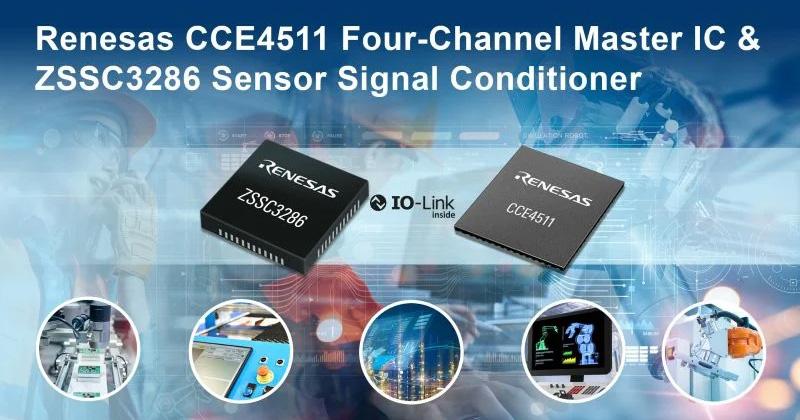Microchip Launches PIC64 Portfolio for Embedded and Space Apps
Microchip Technology introduced its PIC64 portfolio to address the growing need for power efficiency, hardware-level security, and high reliability in real-time, compute-intensive applications like smart embedded vision and machine learning (ML). The PIC64 family aims to provide a single-vendor solution for microprocessors (MPUs), catering to markets requiring both real-time and application-class processing.
The first release in this new product line, the PIC64GX MPUs, supports intelligent edge designs across various sectors, including industrial, automotive, communications, IoT, aerospace and defense.
Moreover, Microchip announced the PIC64 High-Performance Spaceflight Computing (PIC64-HPSC) MPUs to meet the growing computational needs of the expanding space market. Experts project the space sector to grow from $344 billion in 2023 to $755 billion by 2035. This evolution follows two decades of advancements since trailblazing processor-powered missions like Deep Impact and Mars Curiosity rover.
With the introduction of its PIC64 portfolio, Microchip has become an embedded solutions provider actively developing a full spectrum of 8-, 16-, 32- and 64-bit microcontrollers (MCUs) and MPUs. In an interview with EE Times, Shakeel Peera, VP of strategy and marketing for Microchip’s FPGA business unit, and Venki Narayanan, director of marketing for Microchip’s FPGA business unit, discussed the significance of Microchip’s latest portfolio launch concerning the renowned PIC family.
The introduction of Microchip’s inaugural 64-bit embedded processing solution represents a substantial advancement in computing capabilities tailored for the intelligent edge. Positioned as part of a broader multi-family MPU roadmap, this innovation ensures improved performance and scalability for future embedded applications, underscoring Microchip’s dedication to pushing the boundaries of 64-bit processing across key industries. (Figures 1 and 2).

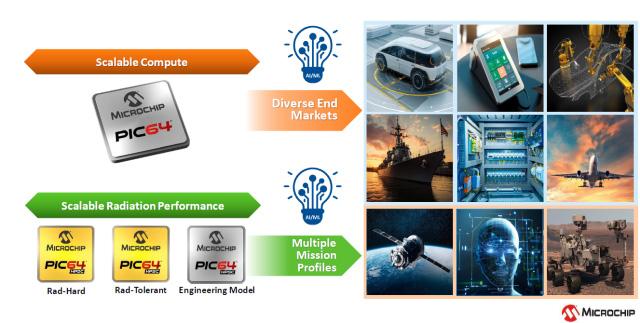
Advancing intelligent edge computing
Peera shared the strategic context and detailed the impressive history of Microchip’s MPUs, emphasizing their dominance in the embedded market with tens of billions of devices shipped over the past decades. The PIC64 line is a natural progression from their celebrated PIC family, renowned for its contributions to the semiconductor industry.
Peera highlighted the significant market potential for intelligent edge computing, particularly in sectors like IoT, industrial automation and medical imaging. He explained that the PIC64GX MPU is a quad-core RISC-V processor tailored for these applications, featuring an embedded video pipeline, advanced connectivity options, and a fifth core for system control and monitoring.
“The PIC64GX family features a quad-core RISC-V architecture with significant computing power suitable for AI inferencing and intensive processing tasks at the edge,” Peera said. “It integrates advanced features like video interfaces and Ethernet connectivity, catering to the burgeoning needs of AI and machine learning applications.”
It supports asymmetric multiprocessing (AMP) and keeps the number of transistors low to improve performance. This series is designed to run Linux, real-time operating systems and bare metal applications within a secure boot environment. It has a sixth MCU class monitor, a 2 MB flexible L2 cache at 625 MHz, and CPU clusters that can run Linux.
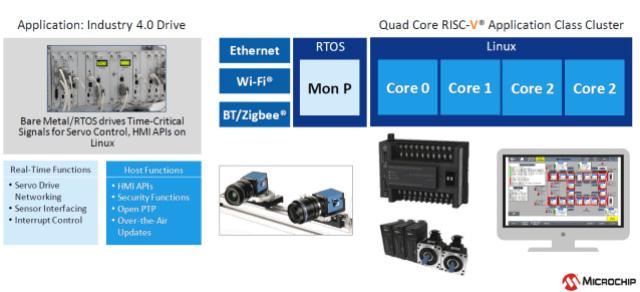
The GX1000 and GX1100 product families feature quad-core RISC-V processors with 5,000 DMIPs, available in packages FCS325 and FCV484. The GX1100 expands capabilities with additional video I/O options (including SLVS EC and DSI-2), AI/ML inferencing capabilities, an enhanced DDR interface and PCIe Gen 2 host support.
Table 1: PIC64GX Family (Source: Microchip)
The GX series targets mid-range computing applications with a 625 MHz multi-core. It features a PCIe Gen two core, while higher-end models with up to Gen five will support advanced virtualization. Future generations will progressively integrate virtualization across the product line, bridging capability gaps.
In addition to the mass market PIC64GX, Microchip is also announcing the PIC64-HPSC, developed in collaboration with NASA JPL. This processor is designed to deliver AI inferencing capabilities in space, enhancing space compute power by 100×.
The PIC64 series marks Microchip’s ambitious entry into the 64-bit MCU market, leveraging the open RISC-V architecture to provide scalable, high-performance solutions for both terrestrial and space applications.
“We are thinking about all aspects of the edge, not just terrestrial edge but space edge as well,” Peera emphasized, highlighting the comprehensive approach of their new product line.
The inclusion of a system controller monitor core was highlighted as pivotal, alongside integrated video interfaces catering to edge applications like AI/ML and imaging. Notably, the product’s robust connectivity options, supporting multiple Ethernet interfaces, were touted as pivotal for modern applications.
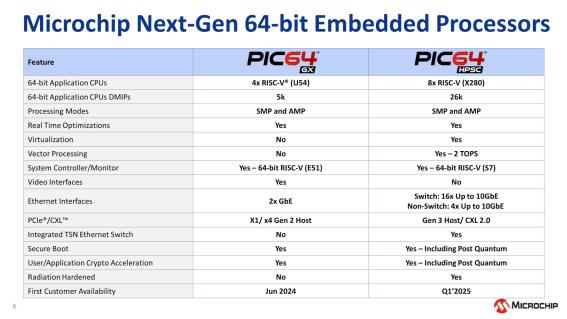
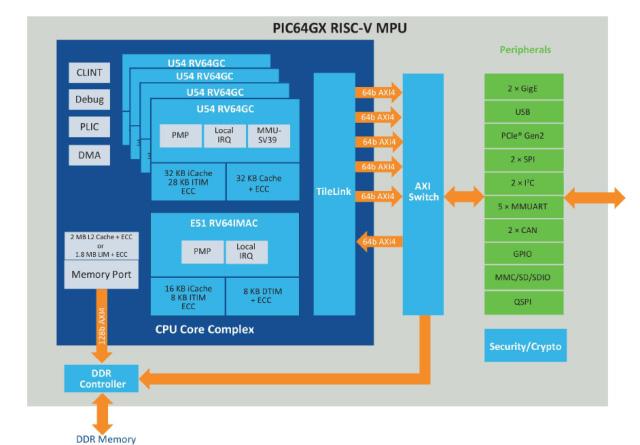
Advancing embedded systems
In the realm of embedded systems, the interplay between real-time performance and versatile computing capabilities continues to evolve. One prominent contender in this arena is the latest generation of processors that seamlessly integrate Linux with real-time operating systems (RTOS), offering a unique blend of symmetric multiprocessing (SMP) and deterministic latency. The GX series represents a leap forward in processing power and efficiency, tailored for applications demanding both high performance and real-time responsiveness.
“At the heart of our design philosophy is the seamless integration of high-performance computing with stringent real-time requirements,” Narayanan said. “Our platform empowers developers to harness the full potential of Linux alongside real-time functionalities, ensuring both flexibility and precision.”
The integration of extensive non-volatile storage is key to its appeal, allowing native Secure Boot to function without relying on external components.
“Our platform features dedicated memory for boot ROM and secure key storage, providing a fortified foundation against unauthorized access,” Narayanan said. At the heart of the GX series is its 2MB cache—a versatile component that enhances the system’s capability to handle diverse workloads seamlessly. Unlike traditional architectures that rely on separate processing units for different tasks, the GX series leverages a homogeneous design, ensuring efficient resource utilization and simplified management.
“The 2MB cache not only boosts performance but also enables asymmetric multiprocessing,” he added. This feature allows different cores within the GX series to independently run distinct operating systems or real-time applications without interference, ensuring deterministic latency critical for time-sensitive operations.
In a configuration emphasizing real time and AMP, this system optimizes performance by dedicating specific resources for deterministic latency and responsiveness. Processor cores operate in MCU mode, ensuring each core’s functionality aligns with its designated task. L1 and L2 caches are tightly coupled, enhancing memory access efficiency.
To uphold real-time demands, CPU branch predictors are disabled. The setup employs AMP mode, segregating resources between a dedicated core for real-time operations under an RTOS and others running SMP Linux, with L2 cache partitioned to 1MB each for RT and Linux, respectively, ensuring efficient operation and prioritized task execution.

In terms of connectivity and expandability, the platform supports a comprehensive array of interfaces including DDR, LPDDR, Gigabit Ethernet, PCI Express, MIPI CSI/DSI and HDMI 1.4.
“Security remains paramount in embedded systems, especially in sensitive environments such as industrial automation or medical devices,” Narayanan said. The architecture includes a built-in crypto accelerator for Root of Trust, fortified against side-channel attacks like differential power analysis. These measures provide robust protection crucial for safeguarding sensitive data and ensuring operational integrity in challenging scenarios.
Countermeasures against tampering and hardware-based security modules for cryptographic operations make security even better by blocking unauthorized access and ensuring the integrity of data processing in mission-critical situations.
The PIC64GX family boasts pin compatibility with Microchip’s PolarFire SoC FPGA devices, offering a large amount of flexibility in the development of embedded solutions. “Future developments include system-on-modules and a suite of comprehensive development tools, enhancing adaptability across various embedded applications,” Narayanan added.
Microchip’s commitment to customer-centric innovation is further underscored by its support for open standards and development ecosystems. The GX series is compatible with popular build systems like Yocto and Microchip Buildroot, facilitating seamless integration into existing software environments and accelerating time-to-market for developers.
The GX product line from Microchip introduces cutting-edge features tailored for diverse applications like LiDAR technology and advanced ML tasks using TensorFlow. Equipped with robust hardware support, the GX series facilitates precise environmental sensing and mapping through its integrated LiDAR interface. This interface supports seamless integration with LiDAR sensors, enabling high-resolution 3D scanning and mapping functionalities crucial for applications ranging from autonomous vehicles to industrial automation.
Moreover, leveraging the TensorFlow framework, the GX series empowers developers to deploy complex ML models directly on the device. TensorFlow’s integration allows for the efficient execution of AI algorithms for tasks like image recognition, natural language processing and predictive analytics. This capability is pivotal in enabling intelligent decision-making at the edge, enhancing real-time processing speeds and reducing dependency on cloud computing for AI tasks.
The GX product line not only excels in advanced LiDAR capabilities and TensorFlow integration but also offers scalability and customization through its comprehensive development kit. Designed to meet the evolving demands of diverse applications, the GX series provides scalability from prototype to production-ready solutions, making it an ideal choice for developers and engineers looking to integrate cutting-edge technology into their projects seamlessly.
The development kit accompanying the GX series empowers users with the tools and resources necessary for rapid prototyping and customization. Featuring a modular design approach, the kit supports easy integration of additional sensors, peripherals and connectivity options, allowing developers to tailor solutions precisely to their application requirements. This flexibility ensures that GX-based solutions can scale effortlessly from initial concept validation to full-scale deployment, minimizing time-to-market and optimizing development efforts.
The PIC64GX Curiosity Kit includes a 1GB DDR4 RAM, SD card slot, and 1GbE capability, supporting extensive data handling and networking. The Raspberry Pi MIPI connector and HDMI 1.4 interface enhance flexibility for peripheral connectivity and display output. User-friendly elements, such as mikroBUS and a 12-pin header, facilitate additional module integration.
Debug tools like LEDs, push buttons, and switches streamline development, while USB-C and external power options ensure versatile power management. Supported by a JTAG debugger for MPLAB, it is ideal for efficient and comprehensive embedded system prototyping and evaluation.

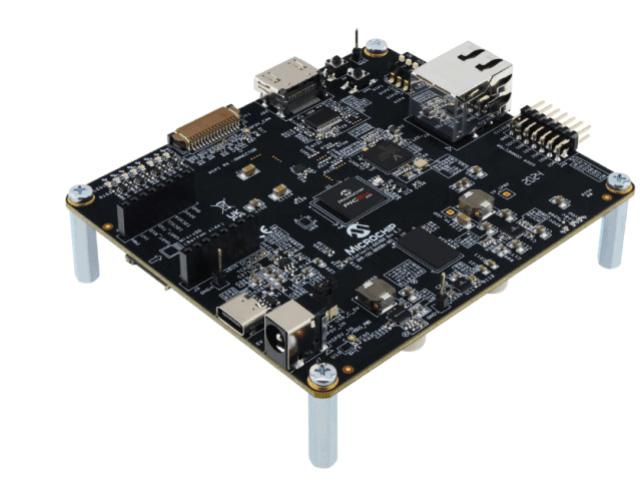
Looking ahead, plans include implementing post-quantum cryptographic algorithms at the software layer, bolstering resistance against emerging threats in the quantum era. “This strategic evolution underscores our commitment to advancing security paradigms without compromising on performance or flexibility,” according to Microchip.
Architecturally, the platform integrates a unified approach to memory management, featuring ECC protection across all memory types to mitigate errors and ensure reliability under demanding operational conditions.
Space computing
The radiation-hardened (RH) PIC64-HPSC is ideal for autonomous missions needing real-time processing, such as lunar rovers, and long-duration deep-space missions requiring low power consumption and resilience in harsh conditions. The radiation-tolerant (RT) variant caters to Low Earth Orbit (LEO) constellations, balancing cost and reliability with essential fault tolerance and cybersecurity. The MPUs vector performance reaches up to 2 TOPS (int8) or 1 TFLOPS (bfloat16), enabling sophisticated AI/ML processing. High-speed connectivity is ensured by a 240 Gbps TSN Ethernet switch, scalable PCIe Gen 3 and CXL 2.0 interfaces, alongside RMAP-compatible SpaceWire ports.
The new MPUs integrate RISC-V CPUs with vector-processing instruction extensions for AI/ML applications, offering significant advancements in space computing for radiation and intensive environments. Driven by needs from NASA, defense, and commercial aerospace applications, these MPUs feature 64-bit architecture, high-speed network connectivity, low-latency data transfers, defense-grade security, and high fault tolerance. They also support dual-core lockstep (DCLS) operation, WorldGuard hardware architecture for partitioning and isolation, and an on-board system controller for fault monitoring and mitigation—all while providing flexible power tuning.
Microchip’s comprehensive ecosystem includes single-board computers, space-grade components and software partnerships, facilitating the rapid development of integrated solutions. This approach aims to replace obsolete, purpose-built solutions with a scalable, high-performance, reusable platform, as endorsed by Northrop Grumman’s Kevin Kinsella. NASA’s selection of Microchip in 2022 to develop a high-performance processor, capable of 100× the computational power of current spaceflight computers, underscores the significance of the PIC64-HPSC for future missions.
At the IEEE Space Compute Conference 2024, representatives from NASA, Microchip, Northrop Grumman, and other industry partners will discuss the HPSC technology ecosystem and impact to the future of space computing. Nasa’s Prasun Desai will provide a keynote, elaborating on the agency’s advanced computing strategy.
Additionally, Microchip’s PIC64GX MPUs, aimed at intelligent edge designs across various sectors, further solidify the company’s position as a comprehensive embedded solutions provider—offering a full spectrum of 8-, 16-, 32-, and 64-bit solutions. Microchip’s portfolio for the aerospace and defense markets includes a wide range of RT and RH components, emphasizing their commitment to advancing space computing technology.
Microchip is set to expand its PIC64 family with new devices based on RISC-V and Arm architectures. This development aims to offer embedded designers a broader range of options, enhancing performance and functionality. By leveraging Microchip’s comprehensive end-to-end solutions—from silicon to embedded ecosystems—designers will benefit from streamlined processes in design, debugging and verification. This integration is designed to significantly reduce time to market for new products.



